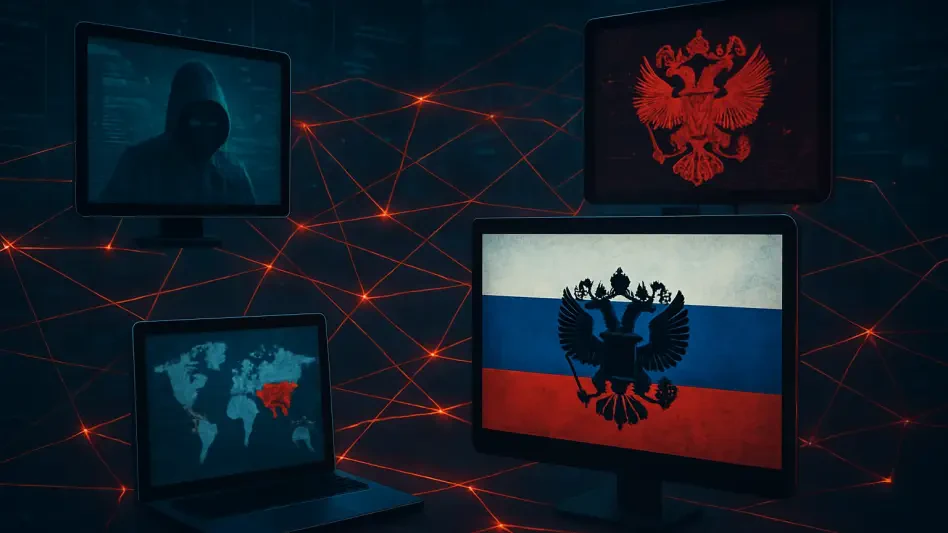In an era where digital security is paramount, the persistent threat of cyber espionage looms large over global organizations, with one Russian state-sponsored group demonstrating remarkable tenacity in exploiting outdated network vulnerabilities. Identified as “Static Tundra” by Cisco Talos Intelligence, this group, linked to the Russian Federal Security Service’s (FSB) Center 16 unit and associated with the broader “Energetic Bear” threat network, has been targeting network devices across the world for over a decade. Their method hinges on a flaw in Cisco IOS software’s Smart Install feature, known as CVE-2018-0171, which, despite being patched years ago, continues to plague unupdated systems. This ongoing campaign serves as a stark reminder of the dangers posed by neglected cybersecurity practices, revealing how nation-state actors can maintain undetected access to critical infrastructure for extended periods, often with devastating consequences for affected entities.
Uncovering a Decade-Long Espionage Campaign
The scale and duration of Static Tundra’s operations set them apart as one of the most enduring cyber espionage efforts targeting network devices. By exploiting a vulnerability that allows arbitrary code execution or denial-of-service conditions, the group gains a foothold in systems that many organizations have failed to patch or replace, often due to reliance on end-of-life equipment. Their approach is systematic, utilizing automated tools to scan for vulnerable devices on a massive scale, likely leveraging publicly available data from internet scanning platforms. Once inside, they employ sophisticated techniques, such as Trivial File Transfer Protocol (TFTP) servers and Simple Network Management Protocol (SNMP) tools, to extract critical configuration data. This data, including credentials and network mapping details, becomes a gateway for deeper intrusions, enabling the group to sustain long-term access while remaining under the radar of traditional security measures.
Beyond the technical prowess, the strategic intent behind Static Tundra’s actions is evident in their alignment with Russian state interests. Cisco Talos, along with corroborating evidence from the FBI, has traced the group’s tactics to FSB Center 16, a unit known for signals intelligence and cyber operations, as well as overlapping activities with other Russian threat actors like Turla. The campaign’s persistence, even in the face of available patches, highlights a critical lapse in global cybersecurity readiness. Many organizations underestimate the importance of timely updates, leaving their infrastructure exposed to actors who prioritize network devices for their central role in communications. This ongoing operation underscores a chilling reality: a flaw addressed years ago can still serve as a potent weapon in the hands of determined adversaries, especially when basic security hygiene is overlooked.
Targeting Across Sectors and Geopolitical Lines
Static Tundra’s victim profile spans a diverse array of sectors, including telecommunications, higher education, and manufacturing, with a geographical reach that touches North America, Asia, Africa, and Europe. This broad targeting reflects a calculated approach to intelligence gathering, focusing on entities that align with strategic national objectives. Notably, since the escalation of the Russia-Ukraine conflict, there has been a marked increase in operations against Ukrainian organizations, evolving from selective compromises to a more aggressive, widespread effort across multiple industries. Such adaptability demonstrates how geopolitical tensions can directly influence cyber campaigns, with the group shifting priorities to maximize impact where it serves state-driven goals, as evidenced by tactical overlaps with previously identified Russian operations.
The implications of this targeting strategy extend beyond immediate data theft to the potential for long-term disruption. Network devices, by their very nature, are high-value targets due to their role as gateways to an organization’s broader systems. Compromising these devices offers adversaries not just a snapshot of sensitive information but also a persistent foothold for future espionage or sabotage. The focus on Ukraine, in particular, illustrates how cyber operations can mirror real-world conflicts, amplifying the stakes for affected regions. Meanwhile, the global scope of Static Tundra’s activities serves as a warning to organizations everywhere that no sector or location is immune to the reach of state-sponsored actors, especially when outdated vulnerabilities remain unaddressed in critical infrastructure.
Addressing the Persistent Threat of Old Vulnerabilities
The enduring success of Static Tundra’s campaign, despite the availability of patches for the exploited flaw, points to a systemic issue in how organizations manage network security. Patch management and device lifecycle oversight are often deprioritized, particularly in environments where budget constraints or operational continuity take precedence over updates. This gap allows nation-state actors to exploit known weaknesses repeatedly, turning what should be a resolved issue into a gateway for sustained espionage. The reality is that network infrastructure remains a prime target for multiple adversarial groups, not just Static Tundra, due to its pivotal role in organizational operations and the extensive access it provides when compromised.
Looking back, the prolonged nature of this campaign revealed significant shortcomings in global cybersecurity practices that demanded urgent attention. It became clear that organizations needed to act decisively by implementing robust patch management protocols and phasing out obsolete hardware to close these exploitable gaps. Collaborative efforts between private sector entities and government agencies also proved essential in sharing threat intelligence to counter such sophisticated operations. As nation-state actors continued to refine their tactics, the lessons from Static Tundra’s activities emphasized a critical need for proactive defense measures. Prioritizing timely updates and fostering a culture of security awareness emerged as vital steps to prevent similar threats from exploiting old flaws in the future, safeguarding critical systems against persistent and evolving cyber risks.








